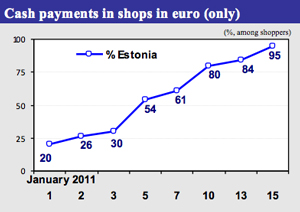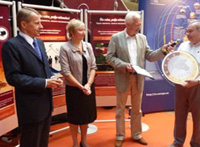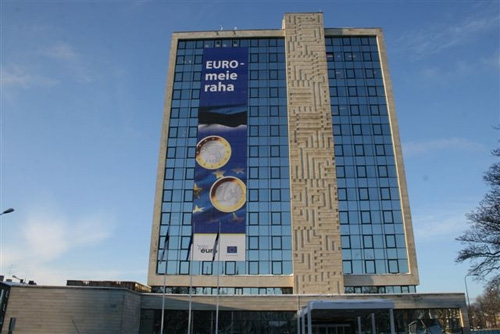

Navigation path
As from 1 January 2011, Estonia is a member of the euro area and shares the same currency with over 330 million people in 17 Member States of the European Union.
|
Press Releases
2011/21 - 11/1/2011 - Estonians are spending their last kroons IP 2011/7 - 6/1/2011 - Euro changeover is proceeding smoothly in Estonia IP 2011/1 - 3/1/2011 - A successful start for the euro changeover in Estonia IP 2010/1777 - 31/12/2010 - At midnight, Estonia will adopt the euro |
On the occasion of the changeover, European Commission President José Manuel Barroso said: "I congratulate Estonia and warmly welcome all its citizens to the euro area. The euro is there to improve everyday life. It makes travel elsewhere in the euro area easier and cheaper for Estonian citizens, with no need to change currencies and pay commission. Estonia's entry means that over 330 million Europeans now carry euro notes and coins in their pockets. It is a strong signal of the attraction and stability that the euro brings to Member States of the European Union".
Olli Rehn, European Commissioner for Economic and Monetary Affairs, said "I am very happy to welcome Estonia into the euro area. This is a great achievement and a fair reward for a country that has been firmly committed to maintaining sound fiscal policies. The single currency will provide a stable framework for the Estonian economy, which together with sound fiscal and macro-economic polices will create the basis for economic prosperity".
The dual circulation period ended on Friday 14 January and the euro is now the only official currency in Estonia.
Thanks to careful preparations, in close contact with the European Commission and the European Central Bank, the changeover has been very smooth and successful. No major problems were encountered and banks, post offices and retailers coped well with the extra workload although some queues unavoidably built up in the first weekdays of the changeover with the number of over-the-counter transactions in banks being 3-5 times higher than usual.
The chart below shows the evolution of cash payments in euro in shops during the two-week dual circulation period (for more details on the cash changeover see Flash Eurobarometer at the very bottom of this page).

On Saturday 15 January, some 13 % of Estonians still had some kroon banknotes in their wallets. These can be exchanged for euros at the official exchange rate and without a service fee in all bank branches that offer currency exchange services until the end of June, and then in a limited network of bank offices for at least another six months. Thereafter, kroons can be exchanged for euros without a service fee in the Estonian Central Bank for an unlimited period of time.
A quick look at the history of the euro...
The euro was created in 1999 when 11 countries irrevocably locked the bilateral exchange rates of their currencies and equipped themselves with a single monetary and exchange rate policy managed by the European Central Bank. Greece joined them in 2001 and in 2002 euro banknotes and coins were introduced thus making the euro a tangible reality in everyday life. Slovenia was the first of the countries that joined the EU in 2004 to adopt the common currency (on 1 January 2007), followed by Cyprus and Malta on 1 January 2008 and by Slovakia on 1 January 2009.

... and the changeover to the euro in Estonia
Just as the other Member States that introduced the euro after 2002 (but unlike the 'first wave' euro area members), Estonia decided to put euro banknotes and coins into circulation on the same day as the euro becomes the country's official currency. This is known as the 'big-bang' scenario.
There will however be a dual circulation period of two weeks, starting on 1 January 2011, during which the two currencies will circulate alongside each other in order to allow for a gradual withdrawal of Estonian kroons. The irrevocable exchange rate between the two currencies is 1 EUR= 15.6466 EEK. In order to make it easier for consumers to get used to the new scale of monetary values, prices must be displayed both in kroons and euro as from 1 July 2010 until 30 June 2011.
Some 194 million euro coins (with the Estonian national side) and some 45 million banknotes are needed in order to introduce the euro in cash.

Flash Eurobarometers
Additional tools